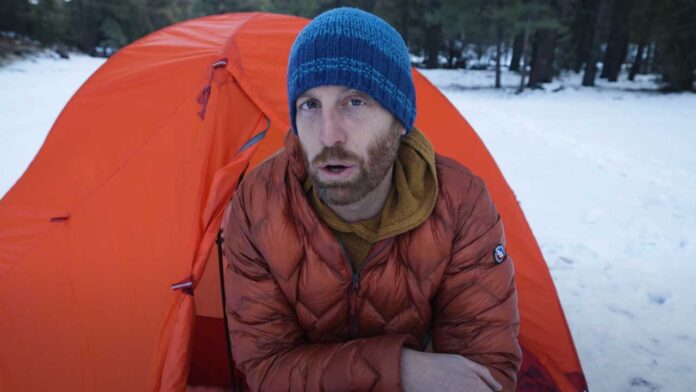Camping and/or backpacking in the winter can be a fun challenge, and a great way to stave off those indoor doldrums, but there are also plenty of pitfalls to watch out for. I see newbies shoot themselves in the foot (metaphorically…hopefully…) all the time, so I want to help steer you in the right direction to avoid winter backpacking mistakes.
Dropping the ball while trying to sustain yourself in freezing temperatures can not only lead to a lousy experience, but potentially, a fatal one. Here's what you can do to adapt.
Winter Backpacking Mistake #1: frozen water filter
A lot of people don't realize that if your water filter freezes, even one time, it is totally dead and can't be revived ever again. If you're using a hollow-fiber filtration system, which covers most filters on the backpacking market (ex. BeFree Lifestraw, etc.) then beware of sub-zero temperatures! If those fibers freeze, they will break beyond repair.
The only thing you can do at that point is get a new one. There are a few products that can rebound after being frozen (but only a few times), such as the MSR Guardian, Rapid Pure, and the Grayl Geopress. These models are designed with a little extra room and flexibility that allows the water to freeze and thaw without catastrophic consequences.
Prevent backpacking water filters from freezing
Preventing common water filters from freezing in the winter (and therefore ruining them forever) is a fretfully overlooked problem amongst backpackers and campers. Your main options are to keep it close at all times, such as in your inside jacket pocket, and definitely bring it into your sleeping bag at night. Whatever you do, keep an eye on it and be proactive, because once those water crystals freeze and burst the hollow-fiber mechanism, that's the end of your water treatment plan.
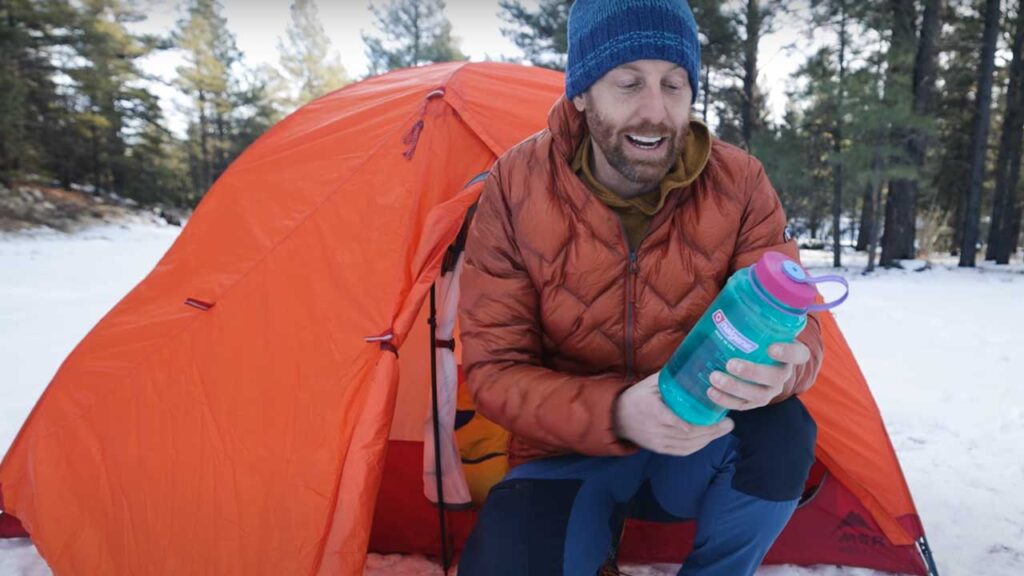
Tips to manage drinking water while winter camping
So if water filters are so finicky in the cold, how do you get clean drinking water while winter camping, and also, how do you keep it in liquid form? What I like to do is fill my Nalgene with boiling water right before bed, chuck it in the bottom of my sleeping bag (to help keep my feet warm), and then in the morning, it will have cooled off enough to drink.
I'll also fill my cookpot with an extra liter of water before turning in, so that in the morning I can light it up, melt the ice that will have formed overnight, and then use that to refill my water bottle.
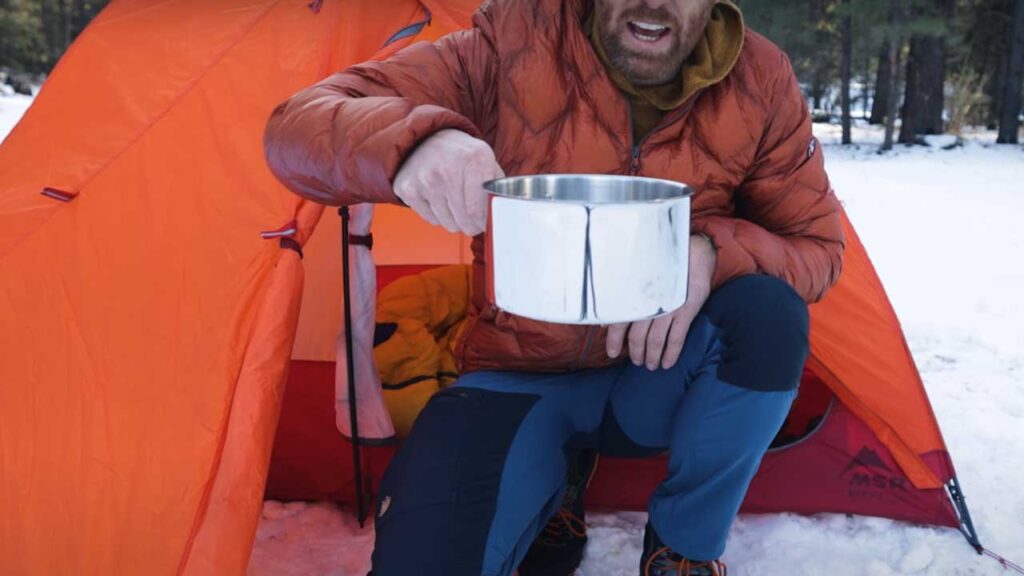
During the day, I'll keep my water bottle close to me so that my own body heat can work its charm. Thankfully, Nalgenes can freeze without breaking, but they still freeze nonetheless if left out for too long. A double-walled insulated water bottle will better resist the slow transformation of your precious water into its not-so-helpful solid form.
Side Note: If you plan on melting snow, add a bit of water to the pot as this will greatly speed up the process. Not sure exactly why, but it works!
Winter Backpacking Mistake # 2: winter cooking fuel

While we're on the subject of melting snow or ice into drinking water, you had better make sure that your fuel itself can handle cold conditions. Liquid fuel is the way to go during this time of year. I'm sorry to break it to you die-hard JetBoil fans, but the isobutane used in those stoves only works up to about 15 degrees Fahrenheit.
Winter Backpacking Mistake # 3: choice in winter layers
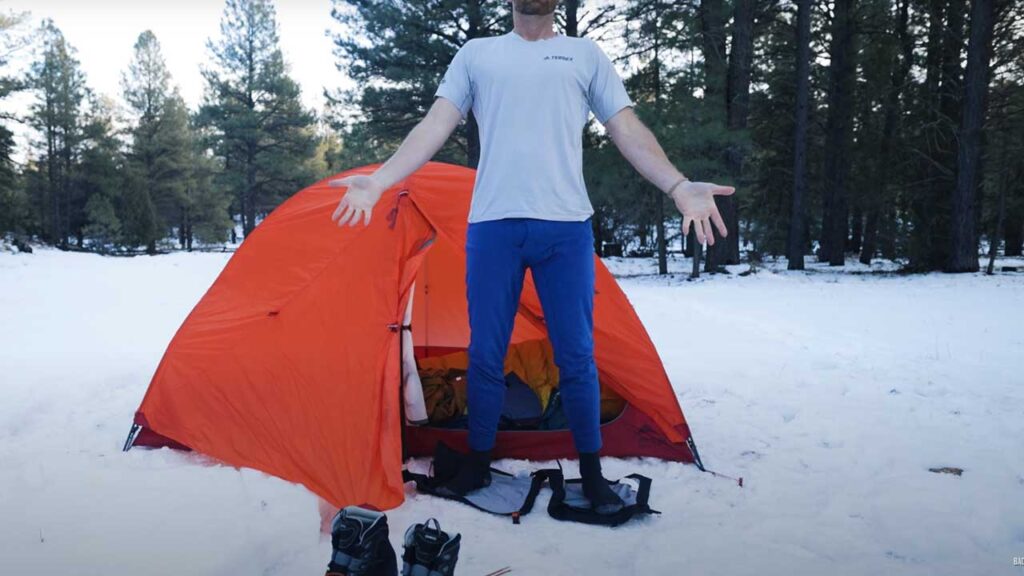
Despite the chill in the air, and maybe even snow on the ground, many wintertime campers still underestimate the importance of layering, or misjudge the types of fabrics to pack. Simply put, don't use cotton.
Base Layers like Merino Wool
Instead of cotton choose performance materials such as nylon, polyester, and Merino wool. Especially for your base layers (underwear, long johns, and socks). These will wick moisture away from your body and dry quickly. But try not to wear pieces that are too form-fitting. Tight yoga pants, for instance, restrict blood flow and therefore make you colder.
Active Mid Layers and a Shell
Once I have a solid base, I like to build on that with things such as a light long-sleeve hoodie and/or a down jacket, and then cap it off with a hardshell jacket and pants. Just be vigilant while hiking or working around camp, as wearing too many layers while active will cause you to sweat, which is a big oh-no-no in the winter. It's better to be slightly chilly while hustling and save your toastiest stuff for the day's end (or extended breaks).
Why is cotton not good for cold weather?
Fresh cotton clothes have their time and place, but definitely not while camping in the winter. Though light, breathable, and natural, cotton also retains moisture (think your common kitchen cloth), and is super slow to dry. These soggy layers will feel cumbersome while moving around and will make you cold the second you settle.
Check the tags for fabric and material
I can't tell you the amount of times I see people rocking big cotton socks, sweats, or hoodies (and I assume underwear) in the backcountry. Check those tags and leave your cotton clothes at home. If you want something light and cozy, get yourself a nice down jacket. Down has the best warmth-to-weight ratio and condenses to practically nothing in your backpack. It's a win-win piece of gear.
Cold weather camping food
Eating calorie-rich foods is important while winter camping. This is not the time of year to skimp on meals in order to reduce pack weight. Giving your body lots to burn, from complex carbohydrates to fatty, and even greasy foods (think salami, peanut butter, etc.), will help generate internal warmth, which your clothes and sleeping bag can then preserve. I also recommend indulging in comfort foods.
Warm winter meals to boost morale
Don't just rely on space-age meals that technically have what you need to survive. Treat yourself to what you love, and you'll get a nice, warm boost in morale. Another fun little tip is to eat before bed. Your body will be asking for fuel to keep itself warm while dormant. A nice bedtime meal has a similar effect to adding a bunch of extra logs to the fire before turning in. So eat well and eat often, and you'll be a lot warmer and happier for it!
Winter Backpacking Mistake # 4: choice in winter tent, sleeping bag & sleeping pad
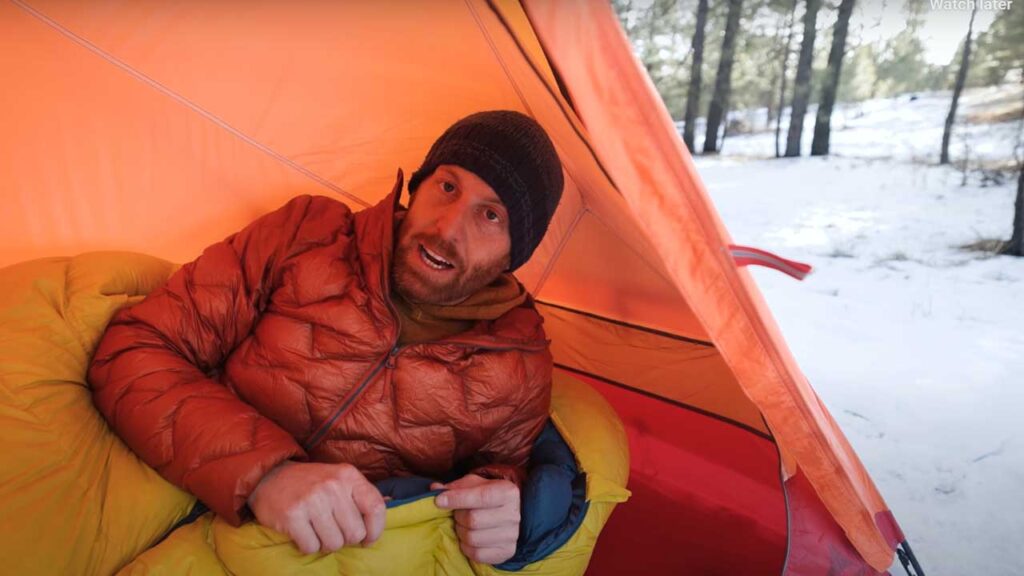
Another common winter backpacking mistake I see out there is a lack of sleeping mattresses, or at least, appropriate ones. Campers may have a hefty sleepy bag (which is a non-negotiable necessity), but without the insulation underneath, the cold will still creep in. To ensure that your mattress is up to the task, have a look at its R-Value. The higher the number, the greater capacity it will have to block the chill coming off the ground.
Winter Sleeping Clothes
Though there is some debate in the backpacking community, I think it is better to sleep in a simple base layer (and maybe a mid-layer) rather than with a puffy jacket. I find this to be more comfortable and actually a little bit warmer since the sleeping bag is then better able to catch and reflect my own body heat.
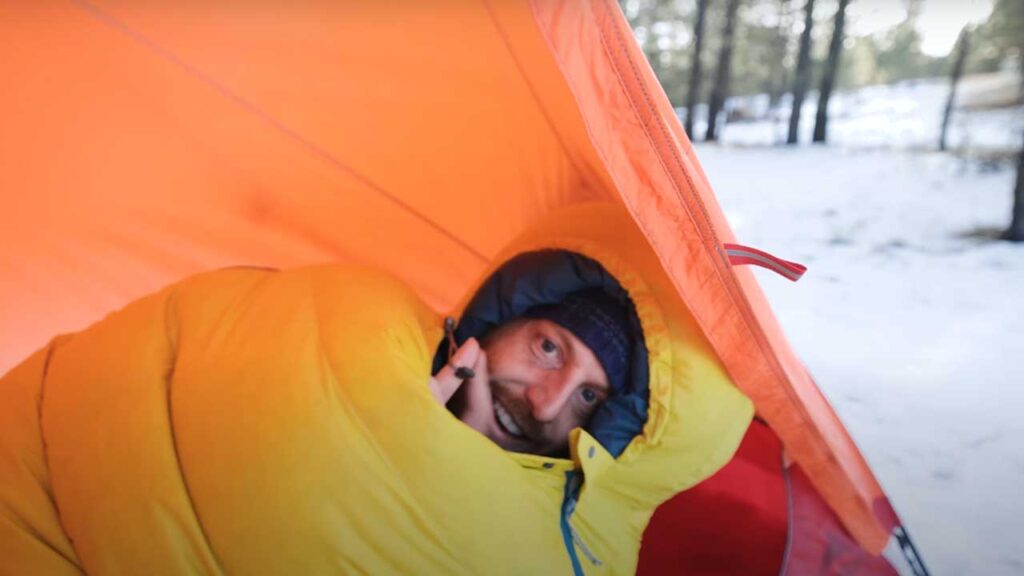
What I prefer to do with my down jacket at night is to stuff it in the hood of my sleeping bag (most high-quality winter bags should have one), or stash it below my feet to help fill some of that dead space in the bottom area (which will also help keep you warmer since your body heat doesn't have to work to warm that open air. The added bonus is that you'll have something nice to slip into in the morning, or in the middle of the night if you have to take a leak.
Draft collar on a winter sleeping bag is important
A draft collar is an inner layer of fabric that also keeps the warm air inside the sleeping bag from escaping as you shift around throughout the night. Just like a hood, a good winter bag should have one of these. Make sure to cinch it up after crawling in so that your body doesn't have to continuously work to keep you comfortable. Just make sure that your entire face isn't covered, as that will trap all of your exhaled moisture throughout the night – and wet does not mix at all with winter (well, the staying warm part, that is). Check out the corresponding BackpackingTV video for a demonstration of how to properly use your hood and draft collar to their full capability.
Down booties for winter sleeping

I love a good pair of down booties for my winter camping excursions. They keep my feet well-insulated in my tent and I'll even sleep with them on if my feet are extra cold. Plus, since they have a hard sole, you can walk around camp with them (as long as the conditions on the ground are reasonable).
Subscribe to our Newsletter
I hope you liked this latest winter backpacking breakdown. Maybe some of these tips/warnings acted as gentle reminders, and perhaps some you're just hearing for the first time. Either way, if you take all of this into account and invest a little bit more in the planning phase, you can have a fun and safe time while backpacking in the winter.
If you want to delve a little deeper into the subject, check out this article on sleeping in cold weather. And as always, subscribe to the In4Adventure.com newsletter or head on over to BackpackingTV for loads of cool videos about everything you need to know to support your year-round adventures.

Gear used in this video includes:
Tent: Marmot Thor
Sleeping Bag: Accent Sleeping Bag
Sleeping Mat: Sea to Summit Comfort Plus Pad
Waterbottle: Nalgene Wide Mouth Water Bottle
Cook System: MSR Whisperlite
Cook Pot: Sea to Summit Alpha Pot



